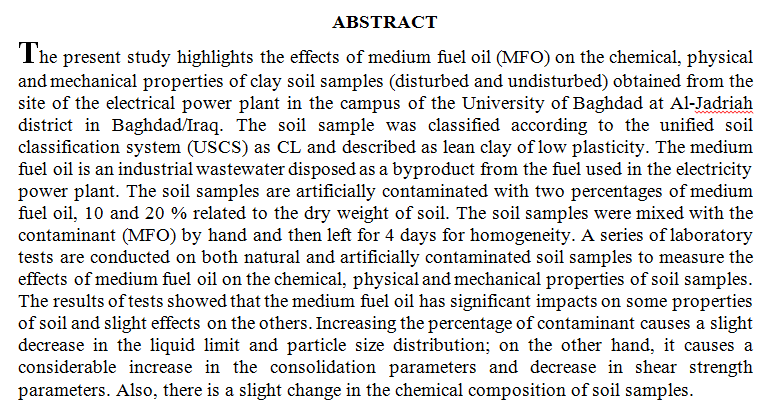
 (24)
(24)
The structural, optical properties of copper oxide thin films ( CuO) thin films which have been prepared by thermal oxidation with exist air once and oxygen another have been studied. Structural analysis results of Cu thin films demonstrate that the single phase of Cu with high a crystalline structure with a preferred orientation (111). X-ray diffraction results confirm the formation of pure (CuO) phase in both methods of preparation. The optical constant are investigated and calculated such as absorption coefficient, refractive index, extinction coefficient and the dielectric constants for the wavelengths in the range (300-1100) nm.
Ti6Al4V thin film was prepared on glass substrate by RF
sputtering method. The effect of RF power on the optical properties
of the thin films has been investigated using UV-visible
Spectrophotometer. It's found that the absorbance and the extinction
coefficient (k) for deposited thin films increase with increasing
applied power, while another parameters such as dielectric constant
and refractive index decrease with increasing RF power.
Thin films of Mn2O3 doped with Cu have been fabricated using the simplest and cheapest chemical spray pyrolysis technique onto a glass substrate heated up to 250 oC. Transmittance and absorptance spectra were studied in the wavelength range (300 -1100) nm. The average transmittance at low energy was about 60% and decrease with Cu doping, Optical constants like refractive index, extinction coefficient and dielectric constants (εr), (εi) are calculated and correlated with doping process.
Thirty one samples of gum swabs were collected from patients with tooth caries (5-30 years old) from the College of Science (Biology department )- University of Baghdad- Iraq for the period from October 2018 to December 2018. , The samples were transported, after inoculation in a transport media (nutrient broth), to the laboratory of the College of Science and then cultured on mannitol salt agar and blood agar). The isolates belonging to Staphylococcus spp. were identified by biochemical tests and Vitek 2 compact system, while the more antibiotic resistant isolates were identified by using Polymerase Chain Reaction(ï´¾PCR) and sequencing of 16SrRNA . The results showed sharp UV absorption peaks at 330 - 340nm and AFM at 5
... Show More (15)
(15)
 (5)
(5)
Background: One of the drawbacks of vital teeth bleaching is color stability. The aim of the present study was to evaluate the effects of tea and tomato sauce on the color stability of bleached enamel in association with the application of MI Paste Plus (CPP-ACPF). Materials and Methods: Sixty enamel samples were bleached with 10% carbamide peroxide for two weeks then divided into three groups (A, B and C) of 20 samples each. After bleaching, the samples of each group were subdivided into two subgroups (n=10). While subgroups A1, B1 and C1 were kept in distilled water, A2, B2, and C2 were treated with MI Paste Plus. Then, the samples were immersed in different solutions as follow: A1 and A2 in distilled water (control); B1 and B2 in black
... Show MoreQ-switched lasers widely used in management skin diseases and
sometimes its effect may be inadequate or associated with
cytotoxicity. The current study aimed to investigate the effect of
Q-switched Nd:YAG laser upon cellular elements using in vitro
experimental model. Aqueous solutions of human albumin and pure
calf thymus double strand deoxyribonucleic acid (ctdsDNA)
irradiated with Q-switched Nd:YAG laser at different rates (1, 3 Hz)
and time exposure (up to 60 seconds) using 532 nm (400 mJ) and
1064 (1200 mJ) nm wavelength with fixed spot size of 4 mm. The
effect of laser irradiation on the albumin solution also studied in the
presence of elemental salts of copper, zinc and iron.
Q-switched laser irrad
In the present work, heterojunction diode detectors will be prepared using germanium wafers as a substrate material and 200 nm tin sulfide thickness will be evaporated by using thermal evaporation method as thin film on the substrate. Nd:YAG laser (λ=532 nm) with different energy densities (5.66 J/cm2 and 11.32 J/cm2) is used to diffuse the SnS inside the surface of the germanium samples with 10 laser shots in different environments (vacuum and distilled water). I-V characteristics in the dark illumination, C-V characteristics, transmission measurements, spectral responsivity and quantum efficiency were investigated at 300K. The C-V measurements have shown that the heterojunction were of abrupt type and the maximum value of build-in pot
... Show More